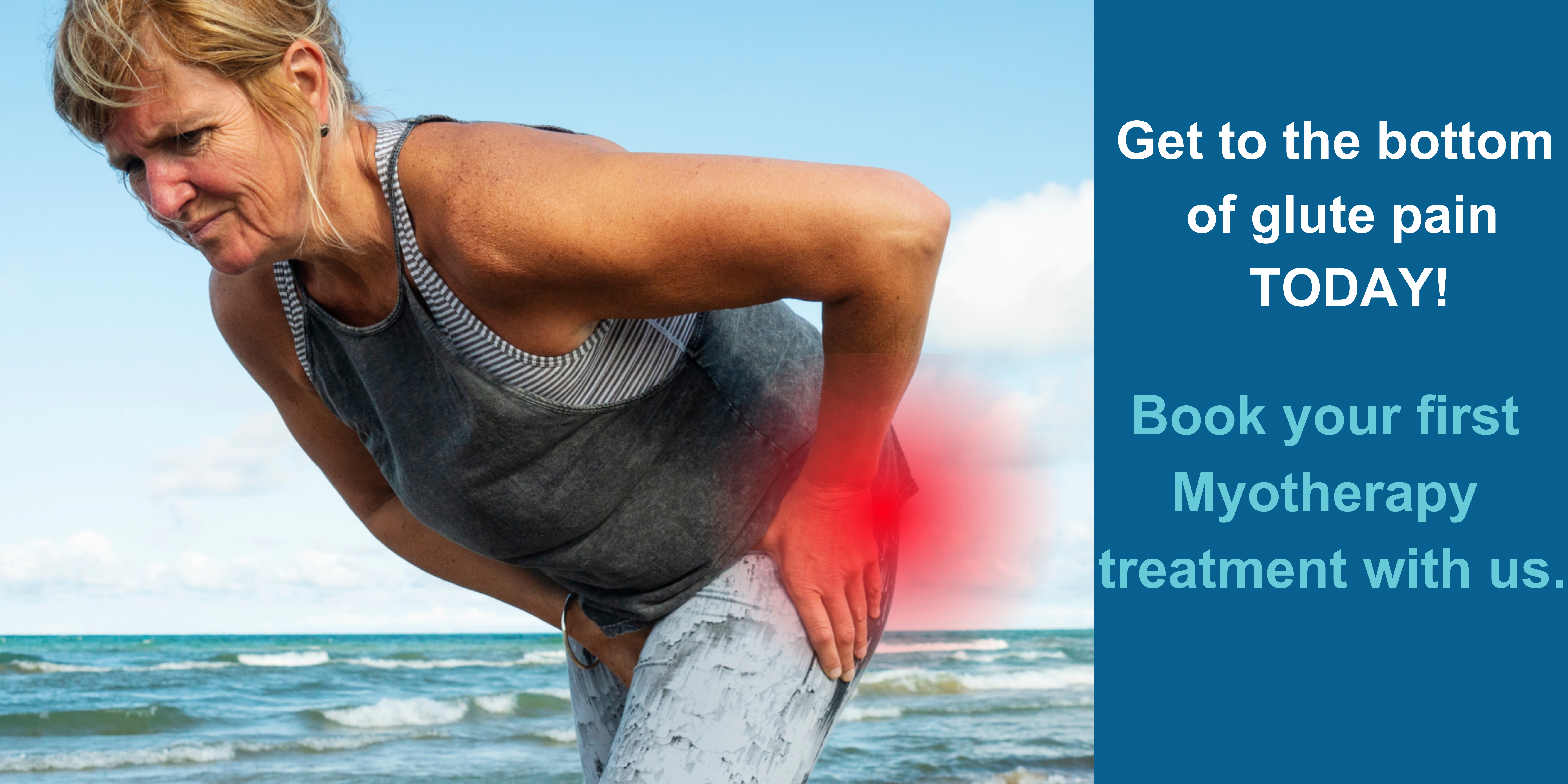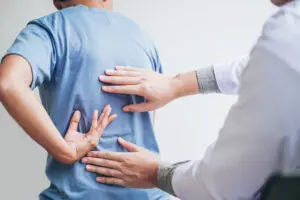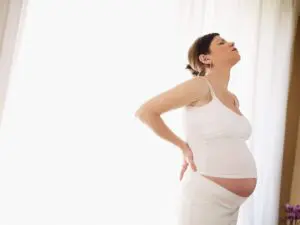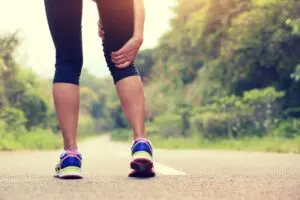
Gluteal Tendinopathy – is this causing your buttock pain?
Gluteal Tendinopathy may likely be the cause of the deep buttock and hip pain you experience when sitting, climbing stairs, or sleeping on your side.
The pain that originates in Gluteal Tendon can refer to the sacrum, buttock, groin, and front of the thigh, therefore, diagnosing the source of buttock pain is complicated due to the overlapping symptoms of numerous conditions such as:
- piriformis syndrome,
- sciatic nerve entrapment,
- lumbar radiculopathy,
- ischiofemoral pathology,
- disorders of the hamstrings or gluteal muscles, etc.
Orthopaedic tests often don’t differentiate between the irritated underlying structures and scans don’t rule out the potential source of pain that contribute to the symptoms.
What is Gluteus Medius Tendinopathy?
Gluteal Tendinopathy or buttock pain is a painful condition caused by deterioration of gluteus medius tendons at the attachment in the greater trochanter. Also known as Greater Trochanter Pain Syndrome, it was traditionally diagnosed as Trochanteric Bursitis. However, recent research shows that the bursal inflammation is a secondary source of lateral hip pain, and that the pain is primarily caused by non-inflammatory tendinopathy of Gluteus Medius and/or Gluteus Minimus muscles. Other structures that could be involved in the pathology are the posterior hip capsule, tendons of Obturator and Gemelli muscles.

What causes buttock pain and Gluteal Tendinopathy?
In Gluteal Tendinopathy, gluteal muscles play a major role in stabilisation of the pelvis during walking and running, making it the hardest working muscle in the hip. Gluteus Medius tendinopathy usually develops slowly over time due to constant overloading of the tendon and eventually can produce pain when the tendon starts to deteriorate. There are certain predisposing factors for the development of gluteal tendinopathy and buttock pain.
- Gluteal Tendinopathy or buttock pain is more common in females than males due to generally wider pelvis and increased valgus angle (angle between the femur and lower leg), which causes greater load on the gluteal tendons.
- Women between 40 and 60 years old are believed to have a higher risk of Gluteal Tendinopathy. Studies suggest that more than 70% of the patients are either menopausal or perimenopausal, indicating a connection between hormonal changes and tendinopathy.
- Sedentary lifestyle and lack of physical activity also leads to weakness of gluteal muscles and reduced capacity of the tendon to tolerate loads of daily movement.
- However, active population, particularly runners, can also suffer from Gluteal Tendinopathy. Glute pain from running may develop because of excessive load of the lateral chain.
What does Gluteal Tendinopathy Pain feel like?
These are the most common symptoms of buttock pain caused by Gluteal Tendinopathy:
- Pain localised to the side of the hip
- Pain with stretching or contraction of the gluteus medius muscle
- Pain when touching the glute tendon at the side of the hip
- Buttock pain when sitting for a long time, especially on a low chair or driving seat
- Buttock pain when standing on one leg, or in a relaxed ‘hip hanging’ position
- Pain with prolonged walking or running
- Pain with walking the stairs
- Hip and buttock pain at night when lying on your side (can be both affected and non-affected side)
- Pain can also refer to the sacroiliac region, the groin, or buttock pain radiating to the anterior thigh, but not below the knee
How is Gluteal Tendinopathy diagnosed?
To know if your buttock pain and hip pain is caused by Gluteal Tendinopathy, first of all, your myotherapist may ask questions about your health history, lifestyle, and other predisposing factors that could indicate a likelihood of tendinopathy. After that, a therapist will do a physical examination, which usually includes palpation of the hip, assessment of movement, and range of orthopaedic tests. Location, severity, and pattern of pain are all very important signs and symptoms that can help confirm the diagnosis.
Book Your Glute Pain Treatment here
Myotherapy for Gluteal Tendinopathy in Brisbane
Management of Gluteal Tendinopathy usually includes hands-on treatment techniques, daily activity modification and targeted exercise plan. Anti-inflammatory medication (NSAID) can also help to reduce swelling within the tendon in the reactive stage of tendinopathy (please consult your GP about medication prescription).
For buttock pain treatment, our myotherapists will use a range of hands-on techniques and exercises to help reduce tendon inflammation and muscle tension around the hip and buttocks. This may include:
- Soft tissue release
- Dry needling
- Electro therapy
- Low-level laser therapy
- Exercise rehabilitation
As the tendon healing may take 3-8 weeks in the reactive stage to over 6 months in the degenerative stage, it is important to have patience and persistently follow an exercise program, prescribed by your myotherapist, to help reduce pain and strengthen affected muscles.
Essential part of Gluteal Pain treatment is patient education on activity and lifestyle modification. Management of provoking factors such as smoking, weight control, hormonal changes, adapting sleeping and sitting positions, is very important for rehabilitation and prevention of gluteal tendon pain in the future.
Frequently Asked Questions (FAQs)
When you have Gluteal Tendinopathy, stretching exercises should be avoided, especially those stretches that involve hip flexion and/or adduction (like TFL stretch, seated/lying cross legged glute stretch), as these positions can cause compression of gluteus medius and minimus tendons by TFL muscle.
Don’t stretch!

Usually, pain from Gluteal tendinopathy is felt at the side of the hip and buttock. It can also refer to the sacroiliac region, the groin, or radiate down the anterior thigh.
Upper buttock pain most commonly associated with:
- Sacroiliac Joint Dysfunction
- Referred pain from the lower back
- Sciatica
There are a few causes of buttock pain that can originate from the lower back.
- Lumbar radiculopathy, particularly Sciatica, which is one of the most common causes of lower back related buttock pain. Sciatic pain often occurs when a herniated disc or narrowing of the spine compresses part of the nerve, giving referred pain along the nerve pathway, including glute pain and pain down the back of your thigh.
- Entrapment and irritation of the nerves (neuropathy) that supply the buttock region can result in aching and burning sensation, tingling or numbness in the glute area.
- Other possible reason is referred pain from injured or overused muscles in the lower back region, such as QL, iliocostalis lumborum or longissimus thoracis (part of the paraspinal muscles), etc.
During pregnancy, hormones cause the ligaments to be more flexible, allowing the pelvis to widen as the foetus grows, and make the labour process easier. However, increased mobility in the sacroiliac joint can contribute to sacroiliac pain and put additional load on buttock muscles. So, there are a few common causes of buttock pain in pregnant women:
- Pelvic Girdle Pain
- Sacroiliac pain
- Sciatica pain from increased load on lower back or tight piriformis muscle
- Gluteal and lateral hip pain from increased stress on the gluteal tendons and bursae
https://pubmed.ncbi.nlm.nih.gov/17678660/
https://pubmed.ncbi.nlm.nih.gov/26955229/
https://www.researchgate.net/publication/318329085_Potential_risk_factors_leading_to_tendinopathy
https://www.physio-pedia.com/Differentiating_Buttock_Pain_-_Gluteal_Tendinopathy
https://www.webmd.com/a-to-z-guides/best-exercises-gluteal-tendinopathy
http://www.utahorthopediccenters.com/hip/gluteus-medius-tendinopathy-or-dead-butt-syndrome/
Related Posts

Bulging Disc Brisbane

SIJ Pain Brisbane

Sciatica Pain Treatments

Liza Markova


Latest posts by Liza Markova (see all)
- Hyperkyphosis - September 19th, 2024
- Frozen Shoulder Brisbane - July 3rd, 2024
- Thoracic Outlet Syndrome Brisbane - September 27th, 2022











